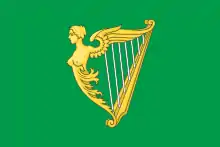Jean Joseph Amable Humbert
General Jean Joseph Amable Humbert (22 August 1767 – 3 January 1823) was a French soldier, a participant in the French Revolution, who led a failed invasion of Ireland to assist Irish patriots in 1798. Born in the townland of La Coâre Saint-Nabord, outside Remiremont Vosges, he was a sergeant in the National Guard of Lyon. He rapidly advanced through the ranks to become brigadier general on 9 April 1794 and fought in the Western campaigns before being allocated to the Army of the Rhine.


Expeditions to Ireland
In 1794 after serving in the Army of the Coasts of Brest, Humbert served under Hoche in the Army of the Rhin-et-Moselle. Charged to prepare for an expedition against Ireland, he took command of the Légion des Francs under Hoche, sailing in the ill-fated Expédition d'Irlande against Bantry Bay in 1796, and was engaged in actions at sea against the Royal Navy. Contrary weather and enemy action forced this expedition to withdraw. The trip home ended in a naval battle, the Action of 13 January 1797, during which Humbert, on the French ship Droits de l'Homme (1794), narrowly escaped death. As the ship was destroyed and sank, hundreds of men perished, but Humbert was among the last to escape.
On his return to France, Humbert served in the Army of the Sambre-et-Meuse, before being appointed to command the troops in another attempt to support a rising in Ireland in 1798. His command chiefly consisted of infantry of the 70th demi-brigade with a few artillerymen and some cavalry of the 3rd Hussars,[1] however by the time he arrived off the Irish coast the United Irish rising had already suffered defeat. The expedition was able to land in Ireland at Killala on Thursday 23 August 1798, meeting with initial success in the Battle of Castlebar where he routed the Irish Militia. Humbert subsequently declared a Republic of Connacht, with hopes of taking Dublin. However, Humbert's small force was defeated at the Battle of Ballinamuck by the Royal Irish Army and he was taken as a prisoner of war by the authorities.[2] The British sent the French officers home in two frigates and then massacred their Irish supporters ; Humbert seems (as Roger Casement later wrote, "to his eternal disgrace") to have made no attempt to save the Irish who bravely supported him. A monument to General Humbert depicting Mother Ireland stands on Humbert Street, Ballina, County Mayo, Ireland.
Later service
Humbert was shortly repatriated in a prisoner exchange and appointed in succession to the Armies of Mayence, Danube and Helvetia, with which he served at the Second Battle of Zurich. He then embarked for Saint Domingo and participated in several Caribbean campaigns for Napoleon Bonaparte before being accused of plundering by General Brunet. It was also rumored that he had engaged in an affair with Pauline Bonaparte, the wife of his commanding officer Charles Leclerc.[3] He was returned to France by order of General Leclerc in October 1802, for "prevarications, and liaison relationships with organisers of the inhabitants and with leaders of brigands".[4] A committed Republican, his displeasure at Napoleon's Imperial pretensions led to him being dismissed in 1803 and he retired to Morbihan in Brittany.
In 1810, after brief service in the Army of the North, Humbert emigrated to New Orleans, where he made his acquaintance with French pirate Jean Lafitte.[3] In 1813, Humbert joined the revolutionary Juan Bautista Mariano Picornell y Gomila in an unsuccessful attempt to foment rebellion in Spanish Mexico, but the effort failed.[5] In 1814, Humbert again left New Orleans and joined the rebelling forces of Buenos Aires, briefly commanding a corps, before returning home. Humbert last fought the British at the Battle of New Orleans, as a volunteer private soldier in U.S. ranks, in the War of 1812, wearing his Napoleonic uniform.[6] General Jackson thanked him for his assistance there after the American victory in January 1815, and thereafter Humbert lived peacefully as a schoolteacher until his death.
Commemoration
In 1989, sculptor Carmel Gallagher unveiled a bust of General Humbert in Killala, Ireland, to mark the upcoming bicentennial of the 1798 Rebellion.[7]
Notes
- F. Glenn Thompson "The Uniforms of 1798-1803" p.50
- See Guy Beiner, Remembering the Year of the French: Irish Folk History and Social Memory (University of Wisconsin Press, 2007)
- Hémard, Ned. "He Fought Pakenham Twice" (PDF). New Orleans Bar Association. Retrieved 8 August 2014.
- Alain Pigeard "Les Étoiles de Napoléon" p.402
- Davis, William (1 May 2006). The Pirates Laffite: The Treacherous World of the Corsairs of the Gulf. Houghton Mifflin Harcourt. ISBN 9780547350752. Retrieved 8 August 2014.
- Union 1812: The Americans who Fought the Second War of Independence by A. J. Langguth
- "STATUES - HITHER & THITHER. Killala / Cill Ala Seaview Terrace".
References
- Thomas Bartlett, 'Général Humbert takes his leave', in 'Cathair na Mart, xi (1991) 98-104.
- Marie-Louise Jacotey, Un Volontaire de 1792 Le Général Humbert ou la passion de la Liberté (Mirecourt, 1980).
- Sylvie Kleinman, Entry, 'Jean-Joseph Amable Humbert (1767–1823), Dictionary of Irish Biography (Royal Irish Academy/Cambridge University Press, 2009).
